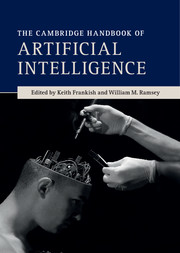Book contents
- Frontmatter
- Contents
- List of figures
- Notes on contributors
- Acknowledgments
- Introduction
- Part I Foundations
- Part II Architectures
- Part III Dimensions
- 7 Learning
- 8 Perception and computer vision
- 9 Reasoning and decision making
- 10 Language and communication
- 11 Actions and agents
- 12 Artificial emotions and machine consciousness
- Part IV Extensions
- Glossary
- Index
- References
12 - Artificial emotions and machine consciousness
Published online by Cambridge University Press: 05 July 2014
- Frontmatter
- Contents
- List of figures
- Notes on contributors
- Acknowledgments
- Introduction
- Part I Foundations
- Part II Architectures
- Part III Dimensions
- 7 Learning
- 8 Perception and computer vision
- 9 Reasoning and decision making
- 10 Language and communication
- 11 Actions and agents
- 12 Artificial emotions and machine consciousness
- Part IV Extensions
- Glossary
- Index
- References
Summary
Introduction
Over the last decade, interest in artificial emotions and machine consciousness has noticeably increased in artificial intelligence (AI), as witnessed by a number of specialized conferences and workshops dedicated to these themes. This interest is in part based on the recognition that emotions and consciousness have useful roles in humans and other animals, and that understanding these roles and implementing models of them on computers might help in making artificial agents smarter. But can machines even have emotions and be conscious, and if so, how could we go about designing such machines?
The goal of this chapter is to present an overview of the work in AI on emotions and machine consciousness, with an eye toward answering these questions. Starting with a brief philosophical perspective on emotions and machine consciousness to frame the work, the chapter first focuses on artificial emotions, and then moves on to machine consciousness – reflecting the fact that emotions and consciousness have been treated independently and by different communities in AI. The chapter concludes by discussing philosophical implications of AI research on emotions and consciousness.
Keywords
Information
- Type
- Chapter
- Information
- The Cambridge Handbook of Artificial Intelligence , pp. 247 - 266Publisher: Cambridge University PressPrint publication year: 2014
References
Accessibility standard: Unknown
Why this information is here
This section outlines the accessibility features of this content - including support for screen readers, full keyboard navigation and high-contrast display options. This may not be relevant for you.Accessibility Information
- 12
- Cited by
